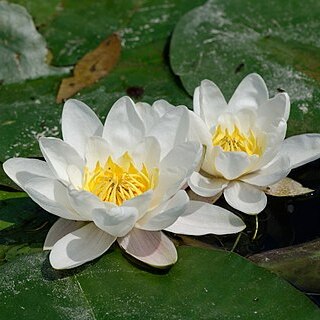Herbs perennial or rarely annual, aquatic. Stems rhizomatous; rhizomes erect or repent, branched or unbranched. Leaves arising from rhizome, simple, alternate, floating, emersed, or submersed, long petiolate but short petiolate on submersed vernal ones; leaf blade undivided, usually with a basal sinus, often peltate. Flowers solitary, axillary, long pedunculate, bisexual, hypogynous to epigynous, actinomorphic, entomophilous, mostly emergent. Sepals 4--7, usually green, occasionally petaloid. Petals numerous (rarely absent), distinct, usually showy, often transitional to stamens. Stamens numerous; anthers introrse, dehiscent by longitudinal slits; connective sometimes appendaged. Pistil 1, compound; carpels 5--many, partially or completely united, surrounding a sometimes projecting floral axis. Ovary multilocular; placentation laminar; ovules numerous. Styles absent or modified into abaxially projecting carpellary appendages. Stigmas radiate on distal surface, often disclike. Fruit berrylike, many seeded, irregularly dehiscent. Seeds mostly arillate; endosperm little, perisperm abundant; embryo small; cotyledons 2, fleshy.
Annual or perennial aquatic herbs with vertical rhizomes or tubers, or horizontal rhizomes, with or without stolons. Leaves alternate or spirally arranged, submerged or floating; petiole sheathing at base or simple; lamina orbicular to elliptic, or sagittate to hastate. Flowers actinomorphic, bisexual, solitary, emergent, standing clear of water or floating, often fragrant; perianth spirally arranged. Sepals 4–6, usually green, yellow or pink. Petals 0 to indefinite (sometimes then interpreted as staminodes), usually showy, variously coloured, sometimes fused at base, either grading into stamens or a gap between petals (or sepals) and stamens. Stamens from c. 8 to indefinite, inserted at top of ovary or adnate to corolla tube; anthers bilocular, dehiscing introrsely or latrorsely; connective sometimes extending as a sterile appendage. Ovary superior, half-inferior or inferior, lobed, multilocular; ovules many per carpel, anatropous, attached all over carpel walls with no definite placenta; stigma 1, sometimes with sterile appendages or lobes. Fruit a berry. Seeds numerous, often arillate.
Aquatic rhizomatous herbs rooted in the bottom mud. Leaves mostly floating, emergent or sometimes submerged, petiolate (petioles often very long), usually ± peltate and with involute vernation; stipules present or absent. Flowers regular, hermaphrodite, solitary, usually large and showy, often scented, mostly long-pedunculate, floating, emergent or rarely submerged. Sepals 4–6, free or adnate to the torus. Petals 6–10 or numerous or even absent, hypogynous or perigynous, imbricate, sometimes gradually passing into the stamens. Stamens numerous; anthers opening by longitudinal slits, introrse or latrorse, the connective often produced. Carpels (6–10–)numerous, immersed in the torus or united into a 3–5-or many-locular ovary; ovules 1–numerous per carpel, pendulous from the walls or apex; styles free, short, or stigmas radiating, sessile on central boss of ovary and also sometimes with marginal stylar processes. Fruit fleshy or spongy. Seeds often with fleshy arils and usually with endosperm and/or perisperm (absent in Nelumbo)
Carpels (6–10) numerous, immersed in the torus; ovules 1 or numerous in each carpel, pendulous from the walls or apex of the carpel; styles free
Carpels 8 or more, free and immersed in the receptacle or more or less united into an ovary of as many cells, inferior or semi-inferior
Flowers bisexual, actinomorphic, solitary, large and handsome, pedunculate, floating, emergent or rarely submerged
Leaves petiolate, exstipulate, floating, emergent or rarely submerged, usually ± peltate, vernation involute
Receptacle large, fleshy, surrounding the ovary and with the petals and stamens inserted on its side
Aquatic herbs with peltate or cordate leaves arising from a submerged prostrate rhizome
Stamens numerous, hypo-or perigynous; anthers introrse, dehiscing by longitudinal slits
Seeds often arillate; endosperm copious; embryo minute, with thick cotyledons
Anthers introrse, often flattened or petaloid, opening by a longitudinal slit
Petals numerous, imbricate, sometimes gradually passing into stamens
Ovules numerous, attached to the sides of the dissepiments
Flowers solitary, large and showy, often sweet-scented
Petals (6–10) numerous, some occasionally ± sepaloid
Aquatic rhizomatous herbs rooted in the ground
Sepals 4–6, free or adherent to the receptacle
Fruit many-celled, indehiscent, fleshy
Seeds with fleshy arils
Fruit fleshy or spongy
Sepals 4–6

